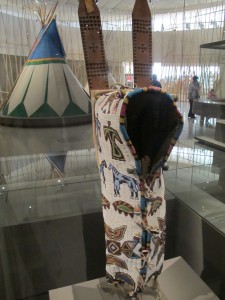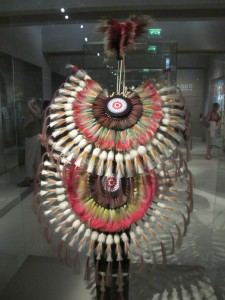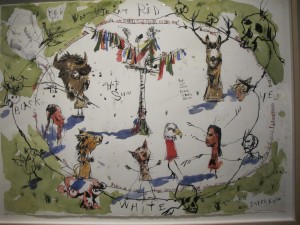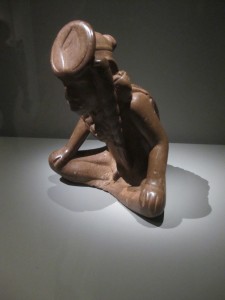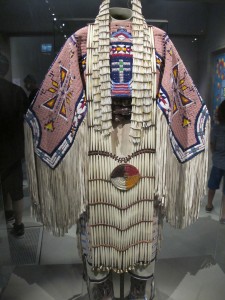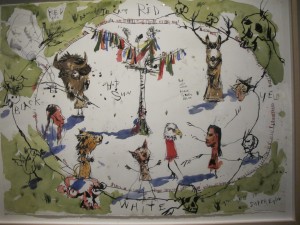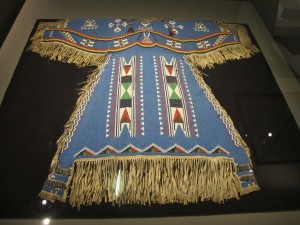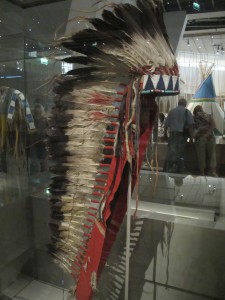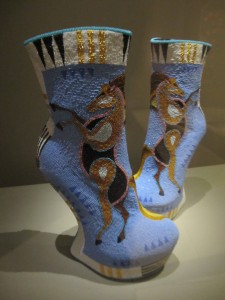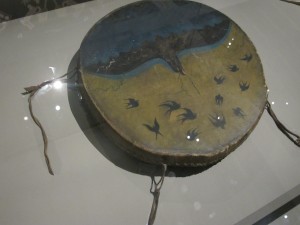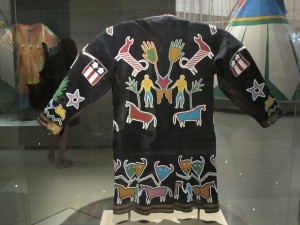At Quai Branly an unusual exhibition has taken the Parisians at heart – showing indigenous people whose traditions and customs have been used in many films and books. However the real Indian mythology and symbolism surpasses by far any fairy-tale.
Baby carrier
An ancient population:
Indian populations lived in the Eastern American forests already 8000 B.C. and 3000 years later spread to the plains.
We have all watched Western movies where the Indians were depicted as warriors and buffalo hunters but that was in fact a very short period in their history of only some 150 years.
As a contrast to those filmed clichés, this exhibition shows a reality of the Indian culture from the 16th century until today. A refreshing reconstruction of a truth too often neglected.
The Indians never stopped creating esthetical artworks. They didn’t have a written language, so added to the spoken language, drawings were another way of expression. The materials used could be a dress in suede, a tipi or a belt…
The objects presented show a mixture of artworks and artists from different epochs.
A historic journey:
The exhibition starts with contemporary and modern American-Indian artists. After years of having been tracked, humiliated and even killed they have reconnected with their roots and use those in their works of art. While using ancient techniques – such as pearl-embroideries for example – or modern ones like watercolours and acrylic, they have re-established a contemporary Indian culture.
The second – and largest – part of the exhibition however takes the visitor back to the beginning of history, at the 16th century, where the meeting with the white man still was relatively sparse.
The Spaniards lived in what is currently called New Mexico. Commerce between them and Indian tribes was active, as shown by exhibited objects such as shells, pipes and feathers.
From 1700 to1820 a central place in the Indian lives was held by buffalo hunting. The buffalos provided them with food, tipis, clothes, and headgears. Their lives changed radically when the Spaniards introduced horses into the country, which enabled them to move and change camps quicker depending on food resources and weather conditions.
Some Indian tribes moved down to the plains – such as the Comaches, Cheyennes, Crees – where they developed specific crafts and culture. The white man further changed the face of commerce by introducing guns.
From 1820-60 the Indian culture had reached its zenith with a special care for nature and spirituality, as shown by the objects created during that period: paintings, drawings, sculptures, embroideries, holy shields, horse masks and headgears made of feathers.
That didn’t last however because the Indians of the plains got chased away by European settlers and were confronted by different tribes from the North and the West with whom they got into conflict. But those wars were nothing in comparison to the white man’s conquest of the West as they were soon to discover at their loss.
Since 1848, the immigrants invaded Indian territories in their search for gold. They destroyed the nature and exterminated the buffalos so the Indians who weren’t killed by their bullets starved to death.
The end of the buffalos and of the Indian culture:
After the 1860s, life for Indians became more and more difficult and strained. Several works are creative examples of the wars fought against the American army that forced them to abandon their traditional lives and accept reserves – often with barren soils – that they were handed. Their handicrafts became their only remaining link to the buffalos and horses. It was mainly the women who kept the traditions alive with their embroideries and paintings on dresses and tipis.
The Indians started using some of the conquerors objects such as gloves, shoes and eyeglasses, displayed in the exhibition, that they adapted to their own tastes with amongst others pearl embroideries.
Pow-wow – gatherings – are still occasions for Indians to meet, sing their songs, dance and revive ancient rituals. The families dress in their best clothes and give each other presents.
This unique exhibition demonstrates the fact that it’s been harder for the white man to end the Indian culture and traditions than killing their buffalos and polluting their beautiful countryside.
It reminds me of another sad story of how we Swedes have treated – and still treat – our own indigenous people, the Sami or Lapps, and their culture. When will the white man learn to respect and love his fellow man?
Anne Edelstam, Paris.


